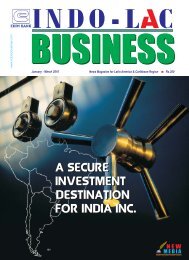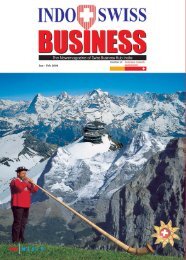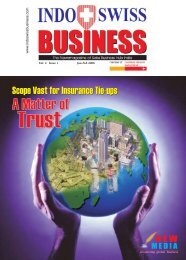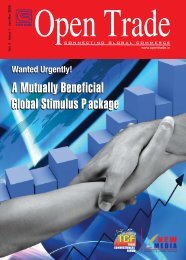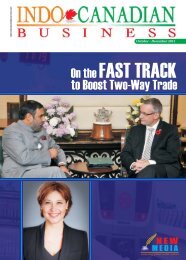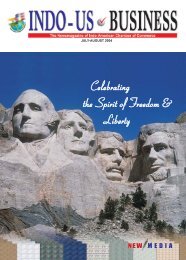Create successful ePaper yourself
Turn your PDF publications into a flip-book with our unique Google optimized e-Paper software.
Allianceamong developed countries as well to enter into trade The intra-bloc merchandise exports as a percentageaccords between themselves as also with developing share of bloc's total exports for European Union has beencountries, as depicted by the increasing share of such as high as 66% in 2005; in case of NAFTA it has beenagreements during 2000-2007 as compared to 1995- 56% and around 50% for East Asia Economic Caucus1999. As a consequence, the share of south-south (EAEC), indicating the high degree of integration amongagreements, which comprised 67% of the total these blocs. Despite having a bloc, there are instances ofagreements during 1995-99, decreased to 39% between trade agreements between countries within a bloc. This2000-2007. Compared to only 10 agreements between distinctive feature is particularly noticed in the CIS tradedeveloping and developed countries during 1995-1999, bloc, where all CIS countries, with the exception ofthe number has surged significantly to 51 during the last Moldova, have entered into agreements with only otherseven years, constituting 46% of the total number of CIS countries. Another interesting feature could heagreements during the period.observed in Japan's initiative towards a trade agreementwith ASEAN, in spite of it having established bilateralDeveloping countries have evinced keen interest inagreements with Singapore and Malaysia, which areengagement in RTAs with more developed nations to gainmembers of ASEAN. Like CIS countries, India and Sriaccess to the larger and potential markets and benefitLanka have also established an FTA, despite beingfrom the immense trade opportunities inherent in thesemembers ot the South Asian Free Trade Agreementmarkets. This subtle and gradual shift in the interest(SAFTA). Similarly, as in case of Japan, India has tradeamong developing countries to engage in agreementswith developed countries and vice versa has beenagreements not only with ASEAN but also with someparticularly noticed since 2004. This could he attributedmember countries viz. Thailand and Singapore.to the interest among developed countries to engage in It may be observed that countries are engaging inbilateral agreements with developing countries agreements with trading blocs as a whole to access thesubsequent to erosion of their confidence in larger and more potent markets of the region. A typicalmultilateralism. It may be cited that for United States, all example in this regard could be the advantage oftrade agreements except those with Israel and Jordan, entering into an agreement with blocs such as EU, whichhave entered into force post 2004.provides access to all member countries of the Union.Emergence of Trade Blocs & RTAsRecognizing this, countries such as Norway, Croatia,Albania, Mexico, Jordan, Algeria, Tunisia, Chile, EgyptThere has also been a fast rise in the number of regional etc. have entered into bilateral trade agreements with thetrade blocs around the globe as a result of the willingness European Union. However, for a member country, aon part of countries to enhance and foster trade customs union or common market could restrict therelationship with neighbouring nations. Countries are choice and freedom to enter into bilateral agreementsalso transcending physical geographical borders to with non-member countries, as the common externalrapidly enter into trade relations with distant countries as tariffs have to be adhered to. This is particularly true forwell. Southern Cone Common Market (MERCOSUR) and larger and relatively more advanced member countries inNorth American Free Trade Area (NAFTA) have emerged the bloc.as major blocs in America. With the emergence ofIt may be also observed that countries in almost allsignificant trade blocs like Association of South East Asianregions of the world are showing an increasing interest inNations (ASEAN) and the South Asian Association forexpanding their trade opportunities with countriesRegional Cooperation (SAARC), Asia too is rapidlybilaterally outside the region or a bloc. In Asia, Singaporeembracing regionalism.has been the most aggressive in its pursuits of regionalCommon Market for Eastern and Southern Africa trade agreements with number of countries like New(COMESA) and Southern African Development Zealand, Australia, United States, Jordan and Panama.Community (SADC) in Africa; Greater Arab Free Trade Singapore is one of the leading RTA signatories with 18Agreement (GAFTA) and Gulf Cooperation Council such agreements in place. Other countries that are(GCC) in West Asia; European Union (EU) and European involved in the most number of RTAs are Mexico withFree Trade Agreement (EFTA) in Europe and the engagements in 19 agreements, Chile with 17Commonwealth of Independent States (CIS) trade bloc agreements, United States with 15 agreements andcould be identified as crucial developments in regional Turkey with 10 agreements. An investigation of the tradeeconomic integration, which have also significantly pattern of these countries over the past decade clearlyenhanced intra-bloc trade.attests to the positive impact of RTAs on the trade29<strong>INDO</strong>-<strong>SWISS</strong> BUSINESS + JAN-FEB 2008




